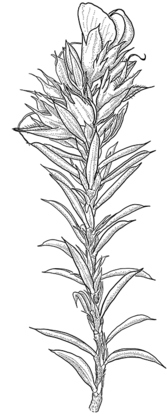Common name: Talbingo Bush-pea
Pultenaea purdieae R.L.Barrett & Clugston APNI* Synonyms: Pultenaea sp. Lobs Hole (M.E.Phillips 176) APNI*

Description: Erect to sprawling shrub 0.4–0.7 m high, young stems with short, crisped, curved and matted hairs to 0.2 mm long.
Alternate, lanceolate, 2.3–6.7 mm long, 0.5–0.7(–1.3) mm wide, mucronate, margins usually strongly incurved.
Inflorescence a head-like cluster. Calyx 3.7–5.2 mm long, tube scattered hairy, lobes with long, spreading hairs. Flowers orange-yellow with yellow and dark red llines at the base of the standard, keel dark brick red at apex. Standard petal 4.8–6.4 mm wide. Ovary with a tuft of long hairs at base of style.
Not seen.
Flowering: October–November
Distribution and occurrence: Between Tumut and Talbingo, from 330 to 550 m, in the Southern Tablelands On rocky slopes in eucalypt woodland or open forest on dark brown to red–brown, rocky loam.
NSW subdivisions: ST
Previously confused with P. lapidosa but differs in the small, glabrous, curved leaves with a short mucro.
Text by R.L.Barrett, March 2025
Taxon concept: Barrett RL, et al. (2024) Revision of the Pultenaea setulosa species complex (Fabaceae: Mirbelieae) including 14 new species. Australian Systematic Botany 37, SB23014. https://doi.org/10.1071/SB23014
APNI* Provides a link to the Australian Plant Name Index (hosted by the Australian National Botanic Gardens) for comprehensive bibliographic data
***The AVH map option provides a detailed interactive Australia wide distribution map drawn from collections held by all major Australian herbaria participating in the Australian Virtual Herbarium project.
|


